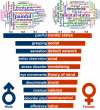Sex-Specific Entorhinal Cortex Functional Connectivity in Cognitively Normal Older Adults with Amyloid-β Pathology
- PMID: 38867110
- PMCID: PMC11711718
- DOI: 10.1007/s12035-024-04243-z
Sex-Specific Entorhinal Cortex Functional Connectivity in Cognitively Normal Older Adults with Amyloid-β Pathology
Abstract
Sex and apolipoprotein E (APOE) genotype have been shown to influence the risk and progression of Alzheimer's disease (AD). However, the impact of these factors on the functional connectivity of the entorhinal cortex (ERC) in clinically unpaired older adults (CUOA) with amyloid-β (Aβ +) pathology remains unclear. A total of 1022 cognitively normal older adults with Aβ + (603 females and 586 APOE ε4 +) from the Anti-Amyloid Treatment in Asymptomatic Alzheimer's (A4) study were included in this study. The 2 × 2 (gender, 2 APOE genotypes) analysis of covariance was performed to compare the demographic information, cognitive performance, and volumetric MRI data among these groups. Voxel-wise comparisons of bilateral ERC functional connectivity (FC) were conducted, and partial correlation analyses were used to explore the associations between cognitive performance and ERC-FC strength. We found that the APOE genotype influenced ERC functional connectivity mainly in the sensorimotor network (SMN). Males exhibited higher ERC-FC in the salience network (SN), while females displayed higher ERC-FC in the default mode network (DMN), executive control network (ECN), and reward network. The interplay of sex and APOE genotype on ERC-FC was observed in the SMN and cerebellar lobe. The ERC-FC was associated with executive function and memory performance in individuals with CUOA-Aβ + . Our findings provide evidence of sex-specific ERC functional connectivity compensation mechanism in cognitively normal older adults with Aβ + pathology. This study may contribute to a better understanding of the mechanisms underlying the early stages of AD and may help develop personalized interventions in preclinical AD.
Keywords: Alzheimer’s disease; Amyloid-beta; Entorhinal cortex; Functional connectivity; Sex Difference.
© 2024. The Author(s).
Conflict of interest statement
Declarations. Ethics Approval: Not applicable. Consent to Participate: The participants screened for the A4 study provided permission to share their deidentified data to advance the quest to find a successful treatment for AD. Consent for Publication: Not applicable. Competing Interests: The authors declare no competing interests.
Figures




References
-
- Hardy J, Selkoe DJ (2002) The amyloid hypothesis of Alzheimer’s disease: progress and problems on the road to therapeutics. Science 297(5580):353–356. 10.1126/science.1072994 - PubMed
-
- Fox NC, Scahill RI, Crum WR, Rossor MN (1999) Correlation between rates of brain atrophy and cognitive decline in AD. Neurology 52(8):1687–1689. 10.1212/wnl.52.8.1687 - PubMed
MeSH terms
Substances
LinkOut - more resources
Full Text Sources
Miscellaneous

